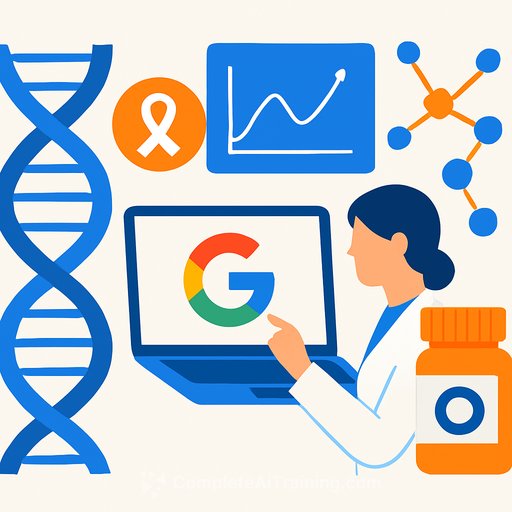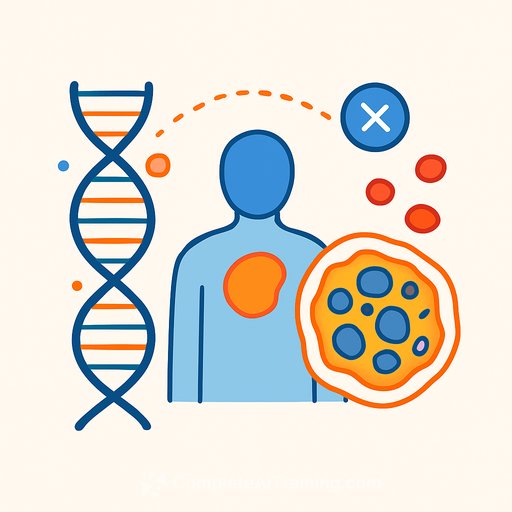Google's C2S-Scale nudges science toward AI-first hypothesis generation
Google has introduced a 27-billion-parameter foundation model, Cell2Sentence-Scale (C2S-Scale), built on the Gemma family of open models. The aim: interpret single-cell signals well enough to propose testable hypotheses for biology and medicine.
In early work, the model scanned large-scale patient and cell-line data, mined the literature, and suggested that silmitasertib could help the immune system spot tumours earlier. Initial lab tests reportedly held up in living cells. That's a clear signal to working scientists: AI is now viable as a hypothesis engine inside the discovery loop.
What the model did-and what it didn't
Silmitasertib (CX-4945) isn't new. It's already in multiple trials and previously received orphan drug status for advanced cholangiocarcinoma. The novelty here is the model's ability to assemble a fresh use case by connecting dots across disparate datasets and papers-not invent a drug from scratch.
That difference matters. It accelerates the front end of discovery-prioritizing hypotheses-while leaving validation, safety, and clinical judgment squarely in human hands.
Expert readouts
Google's researchers framed the result as a milestone: C2S-Scale produced a hypothesis about cancer cell behavior that matched experimental validation. They also argued the model wasn't taught "the rules" of biology; it learned by being rewarded for success and penalized for failure-similar to how top game-playing systems are trained.
From the lab bench view, it's a strong but measured win. One systems biologist called it a well-chosen problem that a focused team could have reached in months. The catch: many labs, especially those with limited access to compound libraries, won't see immediate end-to-end gains without infrastructure.
On the reasoning front, a mathematics professor pointed to steady progress: today's best models perform at skilled levels on structured problems (e.g., Olympiad questions) and increasingly produce novel angles on hard open problems. The field is split on adoption, but there's little evidence that capability growth has stalled.
Why this matters for researchers
LLMs can now assist with three high-value steps: compressing literature into ranked hypotheses, proposing mechanisms with citations, and surfacing drug repurposing angles you might overlook under time pressure. They won't replace wet-lab validation or clinical rigor. They will change where you spend your attention.
If your group has data, assays, and even a lightweight automation layer, you can run shorter hypothesis-to-test cycles. If not, use models to front-load the thinking: better triage, better experiment selection, and clearer negative criteria before you touch a pipette.
Practical actions to take this quarter
- Inventory your data and constraints: sample sizes, modalities (single-cell, bulk RNA-seq, proteomics), and access to compounds or CRISPR libraries.
- Adopt a "model-as-colleague" workflow: ask for top-5 mechanistic hypotheses, expected markers, and the evidence chain with citations; require a counterargument for each.
- Pre-register a small set of falsifiable experiments the model proposes; track wins/losses to calibrate trust and spot bias.
- Set guardrails: banned data sources, off-label suggestions routed through ethics and regulatory review, and automatic provenance logging.
- Close the loop where possible: lightweight lab automation or service providers to run quick assays and feed results back into your prompt templates.
- Upskill the team: prompts for scientific reasoning, uncertainty estimation, and error analysis; basic RL concepts to understand reward-driven model behavior.
Technical notes worth tracking
- Scale and scope: C2S-Scale operates at 27B parameters on top of Gemma. It maps from cellular readouts to human-readable hypotheses-avoid anthropomorphizing; it's pattern-matching across tokenized biology.
- Training approach: less "teaching rules," more success/failure feedback. That favors generalization but can encode hidden dataset biases-monitor where predictions drift by tissue, ancestry, or assay type.
- External validity: patient versus cell-line domain shifts remain a major risk. Demand independent replication and blinded assays before any translational step.
- Compliance: drug repurposing suggestions must pass institutional review, safety assessments, and regulatory gates. Treat outputs as leads, not directives.
Bottom line
C2S-Scale is another data point that LLMs can surface plausible, testable ideas faster. Labs with compound access and rapid assay cycles will benefit most; others can still gain by upgrading literature synthesis, hypothesis ranking, and experiment selection. Treat the model as a sharp junior collaborator-useful, fast, and prone to confident errors without your guardrails.
If you want structured ways to upskill your team on applied AI for research workflows, see our curated options by role at Complete AI Training.
Further reading: Google DeepMind blog for research updates, and clinical context on silmitasertib at ClinicalTrials.gov.
Your membership also unlocks:






